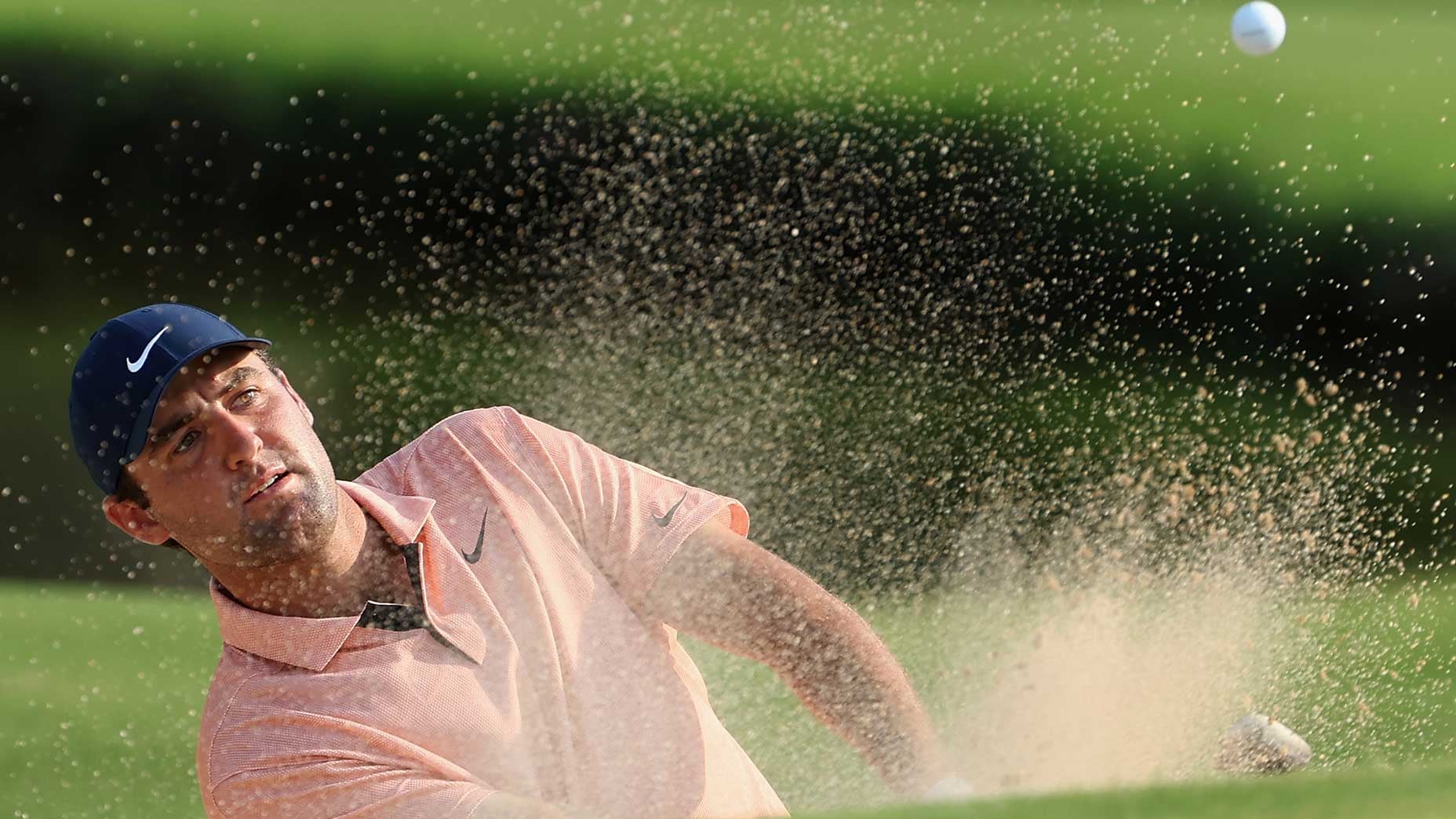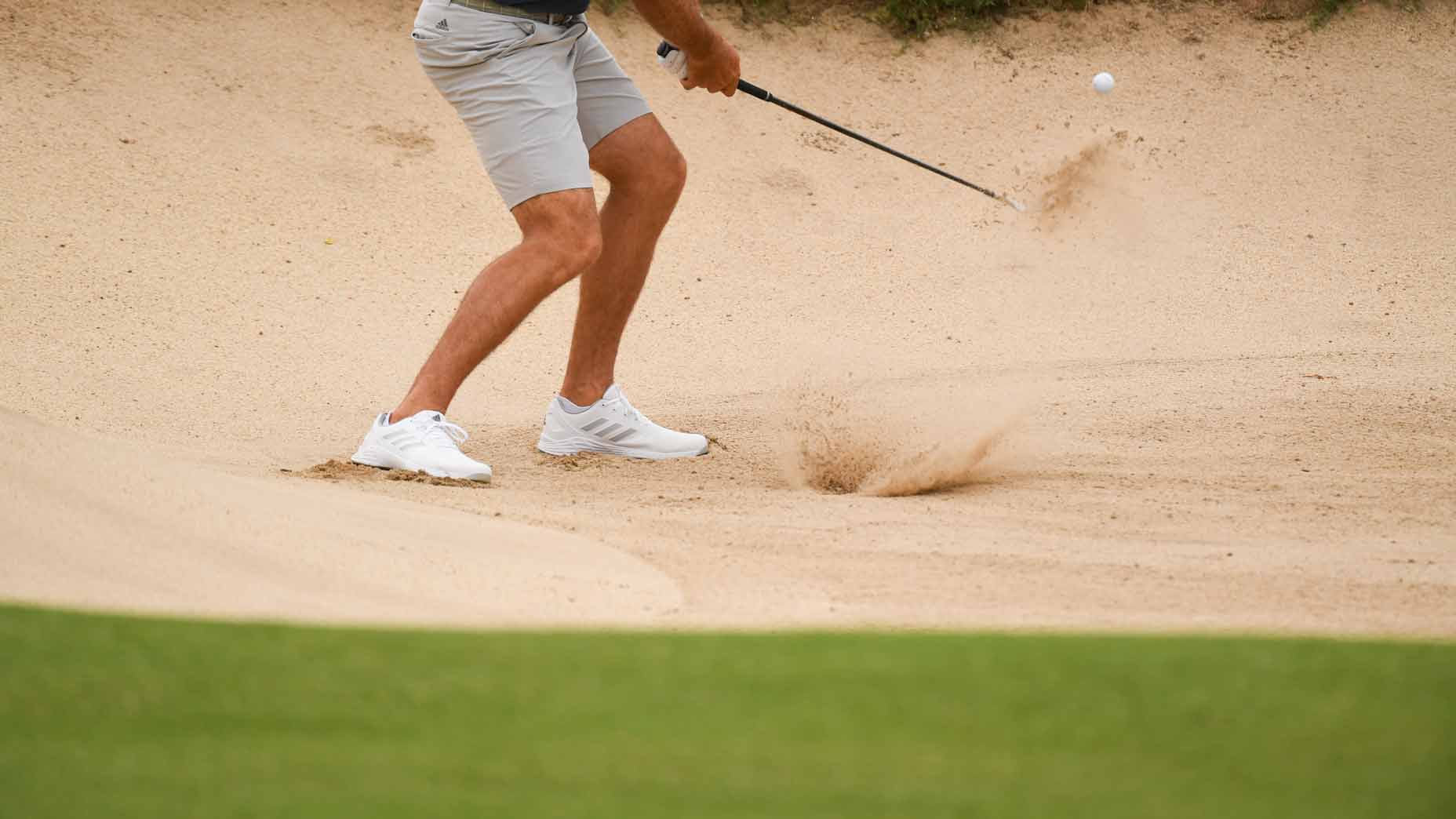
Getting up and down from the bunkers at Southern Hills is proving to be much more difficult than it normally is on Tour.
Getty Images
Justin Thomas stood atop the interview platform Thursday evening, having carded a three-under 67. He was proud of himself for battling Southern Hills in tough conditions, refusing to allow a tough break to ruin his concentration.
He looked out at reporters and answered one question we’ve all been wondering: what’s the deal with these bunkers?
“It’s definitely the hardest sand I’ve — the most challenging sand I’ve ever played in,” Thomas said, “just because, first off, it’s not very consistent. Like on 8 today, I told Bones it was wild. Like my left foot when I was kind of digging in, it was like a little bare I could feel, and then my right foot was like pretty good, like normal, and under my ball was like hitting off this.”
“Hitting off this,” JT said, again, while standing on a felted platform in a media tent in the Southern Hills parking lot. Nothing about that can be easy, consistent, predictable or fun. But that’s how it is at the PGA Championship this week.
Southern Hills’ bunkers, as GOLF.com reported earlier this week, are a bit more “pebbly” than players are used to out on Tour. No, not Pebble Beach-y. Pebbly in the sense that the sand isn’t as fine as normal. Little, tiny rocks you and I would never care about are much bigger than the super fine grain stuff you’d see at the John Deere Classic. As a result, players are a bit confused.
“It’s a little bit of a guessing game at times because this stuff is a little different than what we’re used to,” Talor Gooch said after his 69. “I’m sure some other guys have talked about it, but the individual grains of sand, they’re huge compared to the norm. It makes it a little bit of a guessing game and it makes the bunkers really, really penal.”
Bunkers are supposed to be a hazard, in theory. Gooch made a point of practicing out of the bunkers frequently during his practice rounds earlier this week. It’s one of those things that might impact his score, and might not. You could never really quantify how much early bunker work will eventually help out during the tournament. But Gooch did happen to fly his bunker shot on 16 straight into the cup, some great fortune for the Oklahoma native. Not a birdie, though. Just your normal par-saver.
Another issue with pebbly bunkers is that those pebbles don’t stay put. They also land on the green, and even build up over the course of the day’s play, making things potentially tricky for groups going off in the afternoon. Just ask Scottie Scheffler.
“So there was a lot of putts I had today, especially on the back nine where the pins are close to the bunker, like 17 is a good example, where guys, if there’s some people splashing out of that bunker all those pebbles will shoot out onto the green and can affect your bunker shot, as well,” he said.

Chad Ramey splashes from a greenside bunker at Southern Hills.
Getty Imges
Scheffler found a couple of bunkers late in his round, missing his landing spot, as he would say, by as little as a single yard. The result: two bogeys in his final three holes.
“Bunkers aren’t supposed to be that easy to play out of. It’s frustrating for sure to get in there and have a pebble kind of shoot your ball off line, something you can’t see. I shouldn’t be in too many bunkers and I put myself in I guess three of them today, which is definitely not a place I want to be.”
Ian Poulter warned us all when he spoke with our Zephyr Melton about this issue early in the week. It feels prophetic, now that the shots matter, and you watch Tiger Woods splash a bunker shot on 8 that clunks its way through the shallow sand, the ball nearly rolling through the far side of the green.
Poulter was worried about getting consistent spin out of the sand. That’s one thing these pros care about more than anything else. Spin. And according to Poulter, there’s nothing you can really do to offset any weirdness. You just have to play it normally. And, frankly, avoid those bunkers like you’d avoid a water hazard. The results are just too varied to risk it.
“Some of them have no sand; some of them are good sand, whatever it is,” said Thomas, back up on that felt platform. “But then when you do it’s very pebbly, and sometimes you can kind of get them between the face and the ball and just see them shoot up and off line. I’m sure you’ve seen from watching the coverage, it’s really difficult to get spin; basically impossible.”
We have been watching the coverage. And it’s clear we’re better off on that side of the TV.









